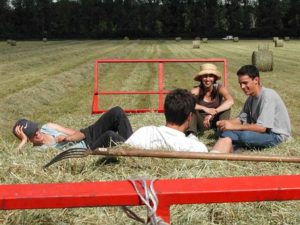
Did you grow up on a big farm or were your grandparents farmers? If you answered yes, then chances are you already have a deep appreciation for what it takes to grow food on a large scale. If you answered no, then maybe your parents or grandparents had a small vegetable garden out in the back yard and you remember helping with it as a kid. Or, maybe you grew up in a more urban area and any kind of gardening or farming experience was miles and miles away. We all ‘know’ farming in a different way.
Through History
If you’re a bit of a history buff, then here is an agricultural time line in the US. The percentage of our US labor force made up of farmers went from 90% in 1790 to 64% in 1850 to 21% in 1930 to only 2.6% in 1990. Might this decline had something to do with the long hours, energy, dedication, and risk-taking that leads to success as a farmer? Yes, and there were other important factors present as our country developed over the past 200+ years.
In Modern Times
Modern facts about farmers from the American Farm Bureau Federation are good to know, too. Here are some that caught my attention and you can read more facts here:
- There are 2.1 million farms in rural America and about 99 percent of U.S. farms are operated by families – individuals, family partnerships or family corporations
- There are 257,454 millennial generation farmers. More than 20 percent of all farmers are beginning farmers which means they have been in business less than 10 years.
- The number of Spanish, Hispanic or Latino farm operators is 99,734 and there are about 45,000 African American farmers and 58,000 American Indian farm operators. Numbers of these ethnic farmers is on the rise.
- Women make up about 1/3 of the total number of U.S. farmer operators.
- About 8 percent of U.S. farms market and sell their foods locally, either direct to the consumer or through re-sale.
Why and How to Find a Local Farmer’s Market Near You
For a colorful and nutritious meal, there is no match to buying food at your local Farmer’s Market. In fact, the reasons to do this go way beyond nutrition and awesome taste so read about 8 Great Reasons to Visit a Farmer’s Market here.
If you are looking for a farmer’s market near you, then Local Harvest is a good place to find it. This website basically organizes markets by city and zip code. So, go ahead and plug yours in to see a local listing. For example, this growers-only, seasonal market in King, NC is only a 25 minute drive from me so I know the vegetables, flowers, eggs, fruits, and everything are really local. At Local Harvest, you will find the street address of the market, website of the market, a list of what is sold at the market, and after you visit then you can leave a review of how you liked it.
How to Enjoy Your Local Farmer’s Market Food
You need to taste it to believe the deliciousness of local farm food. So, a good strategy at the market is to buy a little of this and a little of that. Then, be sure to wash, prep, cook and eat your farm food within a few days for the best of fresh. Each season has unique vegetables and fruits for us. Here’s a little run-down of some favorites:
Early spring: Greens like kale, spinach, lettuce, arugula, radishes, spring onions, pea shoots
Later spring: Strawberries, sugar snap peas, broccoli, cabbage, Swiss chard, kale, asparagus
Summer: Peaches, blueberries, sweet peppers, tomatoes, cucumbers, cauliflower, green beans, cantaloupe, watermelon, fresh herbs
Late summer/Early fall: Figs, apples, pears, Brussels sprouts, potatoes, eggplants, more tomatoes
Which local Farmer’s Market will you visit first and what will be on your shopping list?
